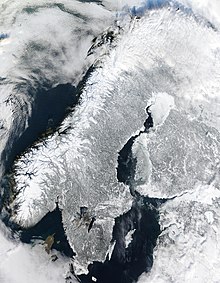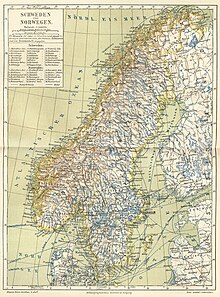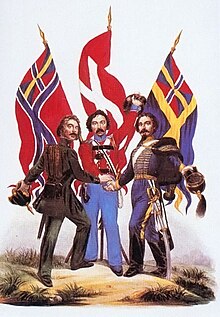Scandinavia
Scandinavia ( Latin Scandināvia (Scadināvia, Scatināvia), Scandia , Norwegian Scandinavia , Danish / Swedish Scandinavia )is a part of Northern Europe , which, depending on the definition, includes different countries, including Norway and Sweden on the Scandinavian Peninsula , as well as Denmark as a rule .
Demarcation
In a geographical sense, Scandinavia is the Scandinavian Peninsula , on which the states Norway and Sweden as well as northwest Finland are located. From a historical point of view and from a linguistic and cultural point of view, Scandinavia in the narrower sense is made up of Sweden, Norway and Denmark . In a broader sense, all of Finland and, more rarely, Iceland and the Faroe Islands are counted as Scandinavia.
From a geological point of view, the Scandinavian Peninsula, together with the rest of Finland , Karelia and the Kola Peninsula, form the geological unit of Fennoscandinavia .
Topography and geodesy
The Scandinavian peninsula was covered in ice during the last ice age. The pressure and movement of the ice masses have shaped the landscape in many parts. A factor that is still important today is the postglacial land elevation . The melting of the ice masses that had depressed the earth's crust has led to a land uplift of 800 m since the last ice age (around 10,000 BC). Nowadays the land elevation, which depends on the geographical latitude, is 10 to 11 mm annually in northern Scandinavia. At the level of Stockholm it is 4 mm, in Skåne it is zero.
The appearance of new seabed is particularly noticeable on the flat coasts : Older beach or fishing huts, jetties, etc. are sometimes located far inland. Ownership issues are also associated with it.
In geodesy , these and other oceanographic phenomena have contributed greatly to the development of earth measurement . The doctrine of isostasy goes back to Fennoscan geodesists and geophysicists, the peculiarities of the Baltic Sea have stimulated the cooperation of several geosciences , and the Ostseering represents the first truly international surveying network.
etymology
Scandinavia was known as Scandza in Greco-Roman antiquity . The term Scandinavia is etymologically related to Schonen ( Scandia ) and the place Skanör . Scadinauia is the oldest Latin name for Scania. The Romans used it to describe everything that was north of Germania . Others see the word origin from the Germanic goddess Skadi .
The term Scandinavia comes from the Latinized form of the Norse term Skaðinaujō (Latin Scadinauia , Pliny the Elder , 23-79). Here skaðin- means “danger” or “damage” ( Old Norse skán- ) and -aujō means “island” or “peninsula” (Old Norse -ey ). The name Scandinavia means something like "the dangerous peninsula", which probably refers to dangerous sea currents around the Skanör / Falsterbo peninsula .
Another interpretation of skaðin- relates to the north wind ( skaði ). As a result, Scandinavia is derived from Skadinavia "the island of the north wind".
In the Middle Ages, the Latin term Terra Scaniae or Terra Scania referred to the regions of Skåne , Blekinge , Halland and Bornholm , today still referred to as Skåneland in the vernacular Swedish and Danish .
history
The earlier history of Scandinavia is marked by the immigration of two Mesolithic hunter-gatherer populations. The first group comes from the Ahrensburg culture and crossed Jutland and the Danish islands. Around 9,600 BC The first settlement in Skåne is traceable. However, several older seasonal camp sites have been found, which show that gatherers and hunters began to hunt on Danish islands shortly after the end of the Ice Age. At that time there was probably still a land bridge between Jutland and Skåne, as the glacial meltwater flowed further north over Lake Vänern into the North Sea. It is discussed whether the settlement took place by boat. There is evidence of settlement on the Swedish coast in Skåne, until finally the Norwegian coast also allowed settlement.
The second major immigration came via Estonia , Karelia and Finland about 1000 years later and is estimated to have been around 8000 BC. Dated. At that time, the Baltic Ice Reservoir changed into the Yoldia Sea , and the Gulf of Finland was gradually formed. This ancient Scandinavian population, which quickly reached the north, lived for around 4,000 years, isolated from the rest of Europe. In the meantime the Baltic Sea turned into the Ancylus Sea and finally the Littorina Sea . It is unclear to what extent these massive environmental changes had an impact on the settlement of Scandinavia.
Only around 3500 BC. With the funnel beakers , agriculture also reached Scandinavia, the northernmost position of which was found on the island of Aland. This is accompanied by the discovery of a plague infection that is closest to the original strain of the plague and was a consequence of immigration. Shortly afterwards they were followed by string ceramists and finally also bell beakers , which were restricted to southern Scandinavia and the far west of Finland. A Baltic Sea trade network between Estonia, Karelia, Finland and Sweden also emerged at this time and shows that similar trade networks that were in contact with the western trade network of the corded ceramics also grew in the Eastern Sea. Kujawien probably played an important role here as a contact group.
A recently published study shows another wave of immigration closely related to the Saami, which occurred around 2000–1500 BC. From the area of the Taimyr peninsula took place. The Nganasans have the closest ties to this and are associated with the Asbestos goods in Finland and Karelia. They also show that the Saami once lived much further south and are consistent with the appearance of reindeer herding. Around 50% of the Finns show genetic traces of this immigration and prove a certain continuity in eastern Scandinavia. Other immigrant groups are associated with Mansi and probably originate from the historical tsarist times, when resettlements are documented.
The recent historical history of Scandinavia is diverse and shaped by different phases of togetherness and opposition. The strong tradition of national historiography in the 19th and 20th centuries was increasingly supplemented by alternative approaches. Nevertheless, the nation-state perspective dominates.
For more than 500 years there was something in common in the foreign policy area, as from the attack of the Danish petty king Chlochilaicus on Gaul (517) to the unfortunate march of Harald Hardrades against England in 1066, the Vikings their raids and wars on all European coastal areas, but also deep into Russia expanded. Another common feature for a long time is the rejection of Christianity in times when it had been widespread in Western Europe for centuries. In addition, the great importance of the Jarle , who were initially only leaders of raids, but as such became very rich and powerful, is characteristic of this time. That is why the feudal system in Scandinavia developed much more slowly than in core Europe, and serfdom did not fully establish itself.
In addition to these general similarities, there were also times when several of the Scandinavian countries were united under one rule, for example under Canute the Great from 1028 to 1035 Denmark, Norway and (loosely) Sweden as well as England were united in a North Sea region . Denmark and Norway were soon under the common rule of Magnus the Good from 1042 to 1046 . But the main time of common political development lies in the Kalmar Union , the countries of Denmark, Norway and Sweden from 1397 to 1523 in personal union were connected. During this time Norway lost a lot of political independence, so that after Sweden left the Kalmar Union with the Danish-Norwegian personal union until 1814, there was practically Danish supremacy, which was replaced in 1814 by the Swedish-Norwegian union, which lasted until 1905.
Finland belonged to King Erik IX since the Swedish conquest . 1154 until it was lost to Russia in the Treaty of Fredrikshamn in 1809 with Sweden.
languages
Scandinavia is primarily described as a cultural and linguistic unit and is characterized by the Scandinavian dialect continuum . The three Scandinavian standard languages , Danish , Norwegian and Swedish , are closely related and mutual understanding between experienced speakers of two of these languages is possible. The North Germanic languages also include Faroese and Icelandic , which differ from the first three so much that communication is no longer possible. The Finnish , however, is not one of this language family.
Known for the Scandinavian countries are the cross flags , based on the Dannebrog , which every modern Scandinavian state carries. Scandinavian provinces and other regions also have cross flags (for example Scania , Småland and Åland ).
See also
- Nordic countries
- North Germanic languages (Scandinavian languages)
- Scandinavian literature
- Scandinavian Defense Alliance
literature
- Jarosław Suchoples (ed.): Scandinavia, Poland and the countries of the eastern Baltic Sea: past, present, future. Wydawn. Uniw. Wrocławskiego, Breslau 2005, ISBN 83-229-2637-5 .
- Nordis (Das Nordeuropa-Magazin) is a German magazine with reports on Scandinavian countries.
- Harm G. Schröter: History of Scandinavia. Beck Verlag Munich 2007, ISBN 978-3-406-53622-9 .
- Fritz Petrick: Norway, history of the countries of Scandinavia. Pustet, Regensburg 2002, ISBN 3-7917-1784-7 .
Web links
- elchburger.de Scandinavia portal
- Historical map as a digitized version of the University and State Library Düsseldorf
Individual evidence
- ^ Karl Ernst Georges: Comprehensive Latin-German concise dictionary . Keyword Scandināvia (Scadināvia, Scatināvia) .
- ^ Duden - The great book of general education, 2014: Entry Scandinavia
- ↑ Wissen.de: Entry Scandinavia , accessed on September 12, 2015
- ↑ Leif Wastenson, Curt Fredén: Sveriges national atlas. Berg och jord. 3rd edition, p. 101. Ed. Sveriges nationalatlas (SNA), Vällingby, ISBN 91-87760-50-9 .
- ↑ Elard Hugo Meyer: Mythology of the Teutons . Phaidon, Essen 1903, ISBN 3-88851-206-9 , p. 236 .
- ↑ Thomas Terberger and Joachim Burger, Migration in the Paleolithic and Mesolithic of Central Europe - Archeology meets Paleogenetics. October 2016, ISBN 978-3-94450-761-3 .
- ↑ Lamnidis et all 2018, Ancient Fennoscandian genomes reveal origin and spread of Siberian ancestry in Europe, DOI 10.1038 / s41467-018-07483-5




